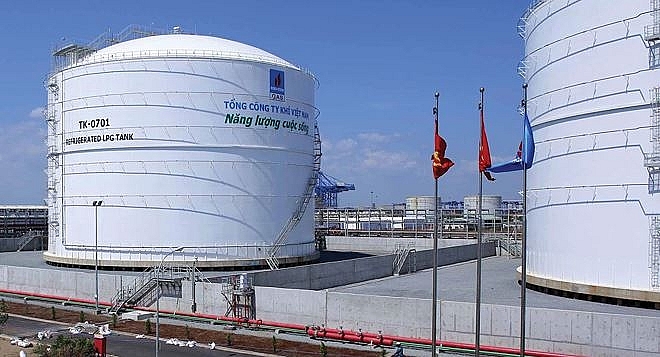Natural gas for electricity generation source: clean yet costly
 |
| Natural gas for electricity generation source: clean yet costly |
According to the head of the Department of Oil, Gas and Coal under the Ministry of Industry and Trade (MoIT), Ngo Thuy Quynh, the ministry has been planning to harness Liquefied Natural Gas (LNG) power plants to replace coal thermal power plants in the near future.
On the other hand, the new plants generating electricity from LNG are facing significant difficulty due to high selling prices.
“It is not easy to develop gas power because its price cannot compete against coal-burning electricity and hydroelectricity. LNG electricity is not incentivised, therefore, all of the expenses will be transferred into the selling price, which causes fierce competition against other energy alternatives,” said Quynh.
Having admitted that the current selling price of LNG electricity is not attractive to investors, Quynh also said that in the long-term, LNG may show its advantages over coal.
According to the MoIT, natural gas in Vietnam is fully exploited for electricity generation and producing fertilisers, and is not available for exportation.
From 2020 and onwards, Vietnam will have to import gas as domestic supply is declining, while the demand of the plants is on the rise.
“In the coming time, Vietnam may import gas via the PM3-Ca Mau pipeline system, to use it in combination with the current gas supply to produce electricity and fertilisers in Ca Mau. This may increase the selling price due to rising costs,” Quynh added.
In line with the MoIT, a number of investors have proposed to build LNG electricity plants in Vietnam. Some of the chosen locations are Ca Na (Ninh Thuan province) as well as Bac Lieu and Long Son (Ba Ria-Vung Tau province).
According to the Japan International Co-operation Agency (JICA), the world’s leading LNG exporters are Qatar, Australia, Malaysia, and Nigeria. In addition, the US is emerging with new technology of exploiting oil and gas from shales.
| From 2020 and onwards, Vietnam will have to import gas as domestic supply is declining, while the demand of the plants is on the rise. |
Some of the world’s leading LNG importers are Japan, Korea, China, India, and Taiwan.
So far, Vietnam has developed numerous thermal power plants fuelled by natural gas, namely the 40,000MW Phu My, Ca Mau 1 and 2, and Nhon Trach 1 and 2 thermal power plants.
However, other than these gas-to-electricity plants, Vietnam will only have more plants after 2021.
The most notable projects are Block B-O Mon complex, Ca Voi Xanh (Blue Whale) power plant in Quang Nam province, and Son My power station.
General director of Phu Quoc Petroleum Operating Company (Phu Quoc POC) Le Ngoc Son said that the Block B-O Mon complex has been under construction since 1997, but has yet to be put into operation.
American contractor Chevron used to be the project operator before 2015. Due to a number of reasons, most importantly a conflict in price negotiation, Chevron withdrew and Vietnam Oil and Gas Group (PVN, PetroVietnam) took over.
After the parties reached an agreement on the gas price after 20 years in mid-2017, the project is currently at the standstill since its exploiting infrastructure is not ready to go on stream. PVN is calling for funding for gas exploitation projects and pipeline systems, while the downstream sector, which includes electricity projects, is struggling to accumulate capital. Therefore, there is a high chance that Block B-O Mon will lag behind schedule.
The feasibility reports of O Mon 3 and 4 power plants have been submitted to the government for approval. However, the government guarantee and undertakings (GGU) procedures supporting foreign investors have not been approved, therefore, they are still hesitant to place investments here.
Son My power station, which was designed to generate electricity from imported LNG, will start the operation of its first plant in 2027.
Son My 1 thermal power plant has the capacity of 2,000MW with three generating units and is scheduled to go on stream in 2027 following the adjusted Power Development Plan VII. The project belongs to Son My thermal power complex, which includes Son My 1, 2, and 3 thermal power plants. The total capacity of the complex is 4,000MW.
LNG will be imported via PetroVietnam Gas Joint Stock Corporation (PV Gas)’s LNG terminal project, which is located in Son My 1 Industrial Zone and planned to be put into operation after 2020. Its first stage has the annual capacity of 3.6 million tonnes and the second stage 6 million tonnes.
The problem is, gas thermal power plants will provide electricity for no less than VND3,000 ($0.13) per kWh, much higher than the current retail price of electricity, which is VND1,720.65 ($0.07) per kilowatt hour.
What the stars mean:
★ Poor ★ ★ Promising ★★★ Good ★★★★ Very good ★★★★★ Exceptional
Related Contents
Latest News
More News
- UOB sees Vietnam growth easing in fourth quarter (December 22, 2025 | 17:39)
- Government moves to establish International Financial Centre (December 21, 2025 | 21:00)
- Vietnam's IFC to target global investment flows (December 21, 2025 | 18:00)
- Ha Tinh breaks ground on major Vingroup industrial and energy projects (December 19, 2025 | 18:24)
- EVN launches major power infrastructure projects nationwide (December 19, 2025 | 18:17)
- VAL inaugurates second production line to meet domestic animal feed demand (December 19, 2025 | 16:37)
- Sun Group pioneers urban tram system in Phu Quoc (December 19, 2025 | 15:00)
- Top 10 notable events of Vietnam’s industry and trade sector in 2025 (December 19, 2025 | 14:00)
- Seven major projects launched to drive Hanoi’s next growth phase (December 19, 2025 | 14:00)
- Rare, beautiful, sustainable: the mark of iconic real estate (December 19, 2025 | 08:00)

 Tag:
Tag:


























 Mobile Version
Mobile Version